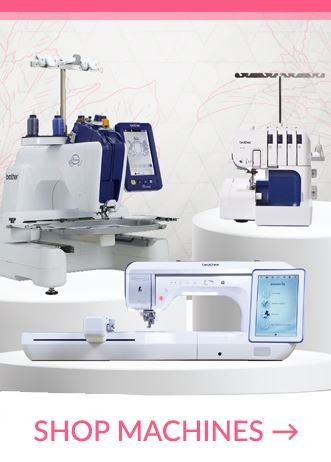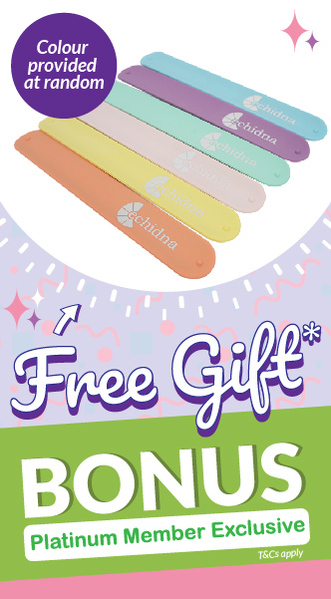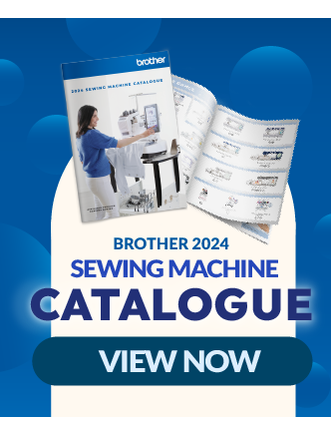Great results with metallic thread
Author: Lindee Goodall
Metallic thread is one of those things we "love to hate." We love the look of metallic thread but it can sometimes be frustrating to embroider with. I'll share some tips and tricks I've learned over the years to get great results. These tips work with any thread and most are just plain good "best practices" for any embroidery.
About metallic threads
Metallic threads are metallized fibres wrapped around a core, which may be nylon, polyester, or rayon, The exterior is a metallicized polyester film.
Many metallics, although labelled 40 wt., are actually closer to 30 wt. in thickness and therefore require a larger needle. Metallic threads also differ in texture. Some are quite coarse, which can cause them to snag in or on the way to the needle. Some are composed of longer "segments" that can make them unsuitable for shorter stitches.
Stiffer, thicker, rougher threads will not perform as well as smoother, softer threads that are the same weight as those the design was originally digitized and tested with (most likely 40 wt rayon or polyester). This is why I love the SoftLight Metallic threads. They are softer feeling than other metallics and are a true 40 wt.; they perform very similarly to rayon so I don't alter my digitizing or my designs when using them. I can substitute them into just about any design as if they were 40 wt. rayon or poly and I don't even need a different needle. They are also "softer" in appearance and less shiny so they provide a more subtle and less garish look to the finished design.
Use a quality thread
This is the number one rule of embroidery no matter what thread you choose. Always, always use a quality brand thread! Pull a length of thread through your fingers. Does it feel thick or rough? Bend the thread back on itself. Does it curve smoothly or does it kink? Does it seem to break incredibly easy? This last test can be hard to gauge because decorative threads are rarely as strong as "regular" sewing thread used for construction. Decorative threads are purely for embellishment and only need enough tensile strength for that purpose. However, if the thread is old, it can become brittle and dry and break too easily.
Maintain the quality after purchasing
Store thread away from light, dust, heat, and air vents. Keep thread clean. Don't use any sticky tapes or rubber bands around the thread for storing.Thread does age and can become brittle and careful storage can extend the life. Many threads manufactured in recent years are treated during the manufacturing process for an extended life.
Don't throw all your threads into a box where they can bang around and become damaged. Handle with relative care and they will reciprocate your kindness!
Use the right needle: type, size, quality
A new, high quality needle (I use Schmetz embroidery needles) can improve the sew-ability of any thread!
A machine needle is a precision made tool, which is designed to perform within very fine tolerances. The needle is the only part of the machine that comes in contact with the upper thread, the fabric, and the bobbin thread. High quality needles are well-polished and smooth. The right size needle is one that carries the thread through the fabric without damage to the thread, the fabric, or itself.
Embroidery needles are designed for high speed stitching with specialty threads. They have a larger eye and groove plus a customized scarf that protects more fragile and decorative threads and reduces shredding and breaking. The larger eye also enables the use of a smaller needle. The smaller needle reduces fabric damage and increases stitch accuracy while the large eye reduces friction on the thread. Friction produces heat, which is not friendly to thread!
Don't use a metallic needle! Metallic needles aren't designed for embroidery. The square, elongated eye is not ideal for embroidery and can actually cause thread breakage.
Maximize thread delivery
While all threads have a twist, it is a bigger problem with metallic thread in that this thread tends to twist on itself more than standard embroidery thread. When the thread twists on itself it can cause knots that will snag in the tension disks or thread guides and cause the thread to break. The best way to avoid this problem is to extend the thread path to allow the kinks to resolve. Also, purchasing thread on larger diameter spools or cones reduces kinking and allows for a smoother delivery – plus it reduces the cost per metre!
An external thread stand is ideal for extending the thread path and on my home machines, I use the Control-A-Twist. It is portable between my machines and I can even use it with my commercial machine.
Thread should also feed off the end of the spool. If the spool has to turn or spin to deliver the thread, this will add extra drag (increased tension) to the thread.
Another device commercial embroiderers often use is to thread the metallic through a styrofoam peanut. I have not personally tried this and I wonder how it might contribute to static. I have sometimes allowed the thread to run through my fingers for a similar effect.
One more thing that can impede thread delivery is a rough spot on the cone or spool. Fine sand paper or an emery board can smooth off any offending snaggers.
Slow the machine down
Yes, I know many machines can stitch at 1000 or more stitches per minute. However, the down side to speed is increased thread tension and increased friction, which produces heat. These factors work together to increase thread breaks. I usually run my machines around 600 - 750 spm.
Monitor machine tensions
You may find you get improved quality by loosening the tensions slightly. Whenever the machine tech services my multi-needle machine, he likes to tighten the tensions too much. Most of my home machines also seem to be set tighter than necessary. Do note that just because your tensions are balanced properly, doesn't mean that they aren't both too tight! If you need to adjust the bobbin tension, it's smart to get a second bobbin case just for embroidery that you can leave set the way you like it.
Also metallic threads have more drag and sometimes this extra drag will cause thread breaks. On a multi-needle machine, the main culprit is the pre-tensioner springs. You may want to purchase an inexpensive Thread Tension Gauge and measure the tension on different types of thread when they are running optimally. Track these values in a small log book so you can reset as needed.
Make sure your machine is clean, with no rough spots
If you've broken needles by hitting the throat plate, a rough edge can be abrading threads as you stitch. The thread gets flossed through the eye of the needle multiple times and if it's catching or rubbing against rough spots, thread breaks increase.
Any buildup of gunk in your machine can decrease performance with any thread and cause tension issues. If you can't clean these areas yourself, be sure to get your machine serviced on a regular basis.
Design choices
Always test your designs first using the threads you intend to use and on the fabric (or similar) and backings you intend to use. Depending on your thread choices, you may find that too many metallics overpower the design and that some metallics don't stitch well in areas of shorter stitches or tighter densities. This is especially true if your metallic thread is thicker or coarser than the thread the design was digitized for. Learn more about how designs are constructed in Anatomy of A Design: How to Think Like a Digitizer.
In general, many lace designs in particular are composed of very short stitches. You will need to be quite selective with metallic thread to find one that sews well. I've had great success with SoftLight on these designs, even running two threads through the needle (size 90) for my Mock Crochet Snowflakes.
And just like needles and thread, you'll get better results from well digitized designs!
Fabric and backing choices
When working with any decorative threads, it's wise to consider the fabric you'll be stitching on. Generally, knits are more forgiving than wovens. Their stretchy nature is just more accommodating and flexible than a tightly woven fabric. While we often talk about embroidery "on" a particular item, in reality, we are embroidering "though" it. Plus, every needle penetration except the first and last has two threads in it – one going in and the other coming out. Very tightly woven fabrics don't have a lot of space between their fibres to accommodate more thread and these fabrics can abrade specialty threads. Softer backings are also kinder to these threads than stiffer ones.
Post embroidery care
You'll have longer lasting beautiful embroidery if you machine wash in cold water on a delicate cycle and avoid bleach and optical brighteners. Press from the wrong side with a press cloth or soft towel. using a low temperature.
For any specialty thread, please refer to the manufacturers care information. Some threads cannot be dry cleaned, for example.
Haven't tried metallics yet?
If you have fallen prey to the idea that metallics are too troublesome for embroidery, I hope you've revised your opinion somewhat! Metallic threads can add that special zing to a design and are especially nice for holiday items. With a well digitized design, a good metallic, along with the rest of the tips listed here – which are pretty much standard tips for any embroider, you should be able to get an excellent result!




